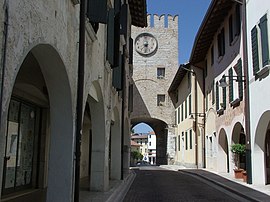Battle of Sacile
| Battle of Sacile | |||||||
|---|---|---|---|---|---|---|---|
| Part of the War of the Fifth Coalition | |||||||
 Porcia, the focus of major fighting |
|||||||
|
|||||||
| Belligerents | |||||||
|
|
|
||||||
| Commanders and leaders | |||||||
| Eugène de Beauharnais | Archduke John | ||||||
| Strength | |||||||
| 37,050, 54 guns | 39,000, 55-61 guns | ||||||
| Casualties and losses | |||||||
| Pordenone: 2,500, 4 guns Sacile: 6,500, 19 guns |
Pordenone: 253 Sacile: 3,846 to 4,100 |
||||||
The Battle of Sacile (also known as the Battle of Fontana Fredda) on 16 April 1809 and its companion Clash at Pordenone on 15 April saw an Austrian army commanded by Archduke John of Austria defeat a Franco-Italian army led by Eugène de Beauharnais and force it to retreat. Sacile proved to be the most notable victory of John's career. The action took place east of the Livenza River near Sacile in modern-day Italy during the War of the Fifth Coalition, part of the Napoleonic Wars.
In April 1809, Archduke John quickly invaded Venetia in northeastern Italy. On 15 April at Pordenone, the Austrian advance guard routed the French rear guard, inflicting heavy losses. Undeterred by this setback and believing he enjoyed a numerical superiority over his opponents, Eugène attacked the Austrians east of Sacile the following day. Though the two sides were equal in numbers of foot soldiers, the Austrians possessed a two-to-one advantage in cavalry, and this turned out to be a key factor in their victory.
Eugène withdrew his army 130 kilometres (81 mi) to a defensible position at Verona on the Adige river, where he reorganized his army and received reinforcements. At Verona, the Franco-Italian army was secure from Archduke John's army advancing from the east and a second Austrian column threatening it from the Tyrol in the north. By the end of April, news of French victories in the Danube valley caused John to fall back to the east, with Eugène in pursuit.
In the early part of 1809, the Austrian Empire of Emperor Francis II determined to go to war against Emperor Napoleon I's First French Empire. Austria massed her main army in the Danube valley under Generalissimo Archduke Charles. Though Italy was considered a minor theater, Charles and the Hofkriegsrat (Austrian high command) assigned two corps to the Army of Inner Austria and placed General der Kavallerie Archduke John in command.
...
Wikipedia
